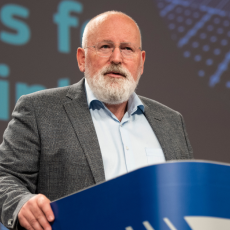Russia’s war on Ukraine has shaken up the energy markets across the continent, with countries and companies focusing on survival first. How has this impacted the continent’s green transition plans? How can a balance be achieved between immediate stability and long-term targets?
In the immediate aftermath of Russia’s invasion of Ukraine, the European Commission launched a plan to end the EU’s dependence on Russian gas. For the short-term, we’re focusing on alternative supplies of gas as well as on energy savings. In parallel, we’re ramping up the rollout of renewables. Now, just 7 months later, only 9% of our gas comes from Russia, compared to 40% previously.
Putin’s manipulation of energy markets has caused energy prices in the EU to soar, making life for millions of families and businesses across the continent increasingly difficult. But this has not affected our long-term climate targets. Europe’s greenhouse gas reduction targets for 2030 and 2050 are fixed in law, and we’re aiming to finalize negotiations on their implementation by the end of the year.
It is true that in the immediate future, we are seeing more coal use than initially projected. At the same time, the EU is switching to renewable energy much faster than anticipated. Solar power capacity is especially expanding rapidly. European citizens and governments know that the era of cheap fossil fuels is over, and that renewables are the only lasting solution to make us immune to Russia’s energy blackmail. So when it comes to our green transition, the European Union is not only staying the course, we are accelerating.
Supply chains have struggled over the past two years, and key sectors like rare earths are still dominated by Asia. What is the EU doing to ensure quick and reliable access to minerals, equipment and components that are critical for clean technologies?
The energy transition indeed requires specific raw materials in higher quantities than before. Certain minerals, like lithium and magnesium, are increasingly being mined inside the European Union. But that does not apply to all rare earths.
Ensuring sufficient supply is therefore a key part of the European Green Deal. We put a lot of emphasis on diversification, as we’ve seen during the pandemic how much global supply chains could be affected by lockdowns in just a handful of countries. The upcoming Critical Raw Materials Act will identify strategic projects all along the supply chain and build up reserves where supply might be at risk.
In addition to this, the move to a fully circular economy is hugely important as well. Research is underway on improving the recyclability of specific metals that are crucial to renewable energy generation. After all, the more you reuse and recycle, the less you depend on imports from third countries.
Following COP26 about 90% of the world’s GDP has committed to net zero. Are these promises turned into real action fast enough, to get us to our 2050 targets in time? If not, where do we need to accelerate with priority?
COP26 was a landmark moment. For the first time, the world has a chance to stay below 2 degrees. But 2 degrees is not the 1,5 we all agreed to aim for. And targets without implementation are just paper tigers. Countries whose targets are not yet aligned with this 1,5 degree future need to update their plans, and everyone needs to set in motion the changes to actually deliver the required emissions reductions.
The countries of the G20 carry a particular responsibility as they emit about 80% of global greenhouse gases. So it’s disappointing to see that some of the world’s major emitters have been trying to backtrack from their commitments. The climate crisis doesn’t wait: we’re already breaking heat records every summer, and we’re seeing more and more massive droughts, horrendous flooding, and extreme heat waves.
At this year’s COP27, a lot of discussions will focus on adaptation. But we cannot adapt ourselves out of the climate crisis. And without sufficient mitigation efforts, no amount of support for adaptation will ever be enough to help vulnerable countries bear the consequences. Having said that, developed countries have to live up to the promises made regarding climate finance and adaptation funding. We’ve all made a commitment there, and it’s time to close the gap to the $100 billion.
Finally, global financial institutions, multilateral development banks and the private sector must quickly align their financial flows with the Paris Agreement. To succeed in this global green transition we need to shift trillions. That may seem like a huge investment, and yet it still dwarfs the human and economic costs of inaction. We simply cannot afford to wait.





